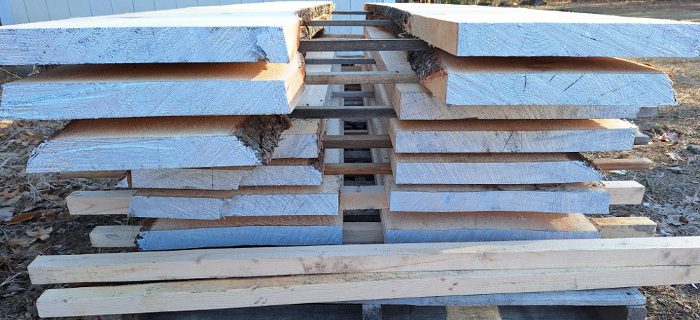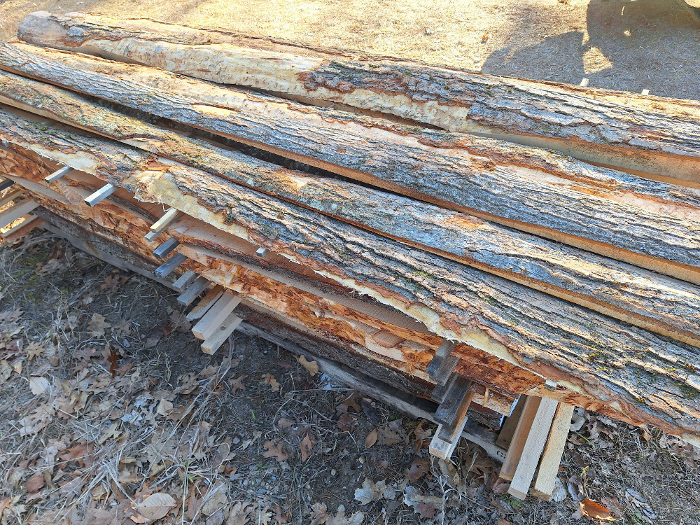Your cart is currently empty!
How To Dry And Protect Live Edge Slabs

When you bring home live edge slabs, they must be properly stored and cared for until you use them in your projects. No matter if the slabs were dried naturally, kiln dried or freshly sawn, care must be taken to ensure they are not warped or damaged before use.
This article discusses how to store and care for your live edge slabs. Follow these instructions immediately when arriving home with your purchase. Any delay can be the ruin of your slab.
Protecting The End Grain
The sawn ends of any piece of wood will dry faster than the flat sides. The ends are called end grain. When wood dries unevenly, it will crack and warp. On the ends the wood will crack deeply, often as far as halfway through the board. This is called Checking. The ends of your live edge slabs must be sealed in order to prevent this from happening.

There is a special, and quite expensive, coating made for protecting the end grain of live edge slabs. But many people simply use an oil based paint to seal the wood. Anything is better than nothing. But a good oil based paint will soak into the end grain and coat it. This prevents water loss through the end grain which then prevents cracking as the wood dries.
Be sure to coat the ends of the board well. Apply a second or even third coat as needed.
Air Drying Your Live Edge Slabs
If you purchased your live edge slab green or fresh from the sawmill it will have to be dried before you can use it. Drying time can vary based on wood species and the moisture content of the logs at the time of sawing. As a general rule you must count for one year of drying time per inch thickness of your board. There are ways to speed this up considerably though.

Wind is your friend – Sun is your enemy
The more wind you can get on your slabs, the faster they will dry out. But sun will cause cracking all over your boards and also bleach them or turn the wood to a gray color.
Find a windy location on your property for drying your live edge slabs. You want the long side of the boards facing into the wind for best results. Place your live edge slabs farther from trees or other obstacles that may interfere with open wind flow around your wood.
You need air flow on both the top and bottom sides of your slab equally. Keep the slab off the ground to prevent moisture entering from the soil. We use pallets for this. Often we place stickers (scrap pieces of 1×1 boards) under the slab every two feet to allow air to flow. Then another row of stickers on top of the slab. Then place sacrificial boards on top of your slab to keep off dust, dirt, sun and rain. Then place weights such as cement blocks, firewood or more boards on top of the pile to keep an even pressure on the boards. This prevents warping as they dry. See the image above for reference. Here we used sawmill rounds – scrap boards from the sawmill – to cover and weight down the boards.
Indoor Dry Your Slabs
Drying your live edge slabs indoors is very much the same as for outside. Prepare the boards off the ground with stickers and weights on top just as for outdoor drying. You need good air flow so indoors you will need fans blowing over your wood. You also need a way for the moist air to escape as your boards dry. If you are drying a large amount of lumber or live edge slabs this could lead to mold in a small room so be sure to ventilate the room as needed.
Caring For Kiln Dried Slabs
If you purchased kiln dried live edge slabs your next actions depend on when you want to use them. If you are going to use them immediately, bring them into the room where the finished product will be used and let them acclimate for a few days to the temperature and moisture content of the room. In this case it is ok to stand them up vertically on end for this process until you use them.
If you are going to leave them for a while you should sticker and stack them as you would with wet live edge slabs. You can also stack multiple boards flat one on top of another in a horizontal position for long term storage.
It is not advisable to store kiln dried live edge slabs outside. But if you must, be sure to protect them from the elements, especially moisture. Keep them stickered and stacked with weight on top until they are ready to use.
Before You Use Your Live Edge Slab
This is very important. Do not skip this step if at all possible. When you bring your live edge slab home or inside for use it should be acclimatized to the room where it will be used. The wood should be left to acclimate to its surroundings for a week or so before you use it in your projects.
Of course this is not always possible but at least a day or two will help some.
Live edge slabs expand and contract and will absorb or release moisture based on their surroundings. This acclimatization time allows the wood to settle into its new environment.

Leave a Reply